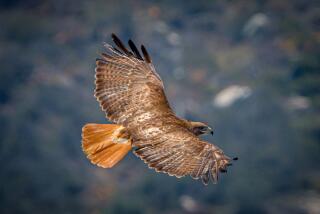Michael Pearce: For a pup, fetching birds is only half the fun on a hunt
- Share via
MARION COUNTY, Kan. It was a simple left to right crossing shot of about 20 yards, the kind that I can make most of the time. (OK, that I can make some of the time.) At the shot I had my first dove of the season. A few seconds later Cade, our four-month-old Lab puppy, was making the first retrieve of his life on a wild bird. By the time the hunt was over he’d fetched all nine that I’d shot, including good finds on solid ground, out in the pond and deep in the flooded smartweed that ringed the shallow water.
All across Kansas on the opening of dove season I’m sure hundreds, if not thousands of hunters and their hunting dogs shared such moments. I doubt if many of those other hunting dogs had as much fun between retrieves as the dog my wife affectionately calls “The Prince of Amuckdom.” My favorite for him is the Tasmanian Puppy. You get the picture, I’m sure.
Here’s part of what comes to mind when I think back to the non-hunting parts of the hunt.
We’d been at the pond for only a few seconds when Cade was belly-deep in the water, his face below the surface as he tried to find where the bullfrog he’d been chasing had gone.
I’d like to think the pup was smart enough to just be trying to camouflage his black self when he bounded from the water and rolled and rolled in a combination of loose dirt and dead grass. He looked like a Chia pet when he was done. Make that an incredibly happy Chia pet.
Somehow I made my first six shots, leaving me to wonder how Cade would react when I missed. He’d been trained on cap guns, .22 blanks and even shotguns since he was eight weeks old, but at the sound of every shot there had always been something to retrieve. Sure enough, when I missed the seventh bird (an easy left to right crossing shot) the young dog didn’t want to give up the search.
At the end of the next hour he was more than conditioned to coming back with an empty mouth because of a long run of “accuracy issues” on my part.
I was setting at the base of a small bluff to help break up my outline. That meant any time he wanted, Cade could circle around and announce his presence atop the bluff with a very wet lick to one of my ears. (I’m not too worried about him holding perfectly steady until he gets a few hunts behind him. (We’ll work more on not going until getting a verbal release as duck seasons open.)
Rolling around atop the bluff he eventually tumbled down the slope and directly into the pond, where he just continued to roll and splash around. He’s as comfortable in water as on land.
A possible catastrophe was avoided when I caught him staring at a fairly fresh cow pie with obvious mischief on his mind.
Several walks to flush birds that landed out of range were interrupted for a butterfly or dragonfly chase.
Several times as killdeer flew by slowly, Cade turned and gave me a, “Hey, you do see those birds, right?” sort of look. It will take a few trips before he recognizes the flight patterns of doves, ducks and other birds we hunt.
Not long before we had to head home at around 6 p.m., Cade was splashing about with a long section of smartweed in his mouth when he stopped, looked to the east and cocked his ears. Over the sound of the wind I heard a rooster pheasant cackling. Though he’s never seen a pheasant or heard their call, Cade took time to sit and listen to the birds cackling. That’s another adventure that will start in about 21/2 months, for both of us.
I’m sure it won’t be dull.
(c)2015 The Wichita Eagle (Wichita, Kan.)
Visit The Wichita Eagle (Wichita, Kan.) at www.kansas.com
Distributed by Tribune Content Agency, LLC.
More to Read
Go beyond the scoreboard
Get the latest on L.A.'s teams in the daily Sports Report newsletter.
You may occasionally receive promotional content from the Los Angeles Times.









